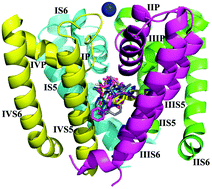Binding mechanisms of 1,4-dihydropyridine derivatives to L-type calcium channel Cav1.2: a molecular modeling study†
Abstract
L-type Ca2+ channels (LTCCs), the heteromultimeric proteins, are associated with electrical signaling and provide the key link between electrical signals and non-electrical processes. 1,4-Dihydropyridine (DHP) derivatives are a major class of blockers for LTCCs, and have experienced widespread use in the treatment of cardiovascular diseases. However, the precise knowledge of the binding mechanism of these ligands to LTCCs at the atomic level has remained unknown because of the unavailability of the crystal structures of LTCCs. In this study, homology modeling, molecular docking, molecular dynamics (MD) simulations, free energy calculations and decomposition were employed to explore the structural requirement of the binding of DHP derivatives to human Cav1.2, a member of LTCCs. The binding conformations of the DHPs in the active site of Cav1.2 were predicted, and the rank of the binding free energies of Cav1.2/DHPs is generally consistent with the experimental data. The structural analysis shows that most studied ligands fit into a hydrophobic pocket formed by Phe1129, Ile1173, Phe1176, Met1177 and Met1509, and form aryl–aryl interaction with Phe1129 or Tyr1508. The consistency between the predictions and experimental data suggest that the developed model is reliable and can be used as a valuable platform for the structure-based design of new potent ligands of Cav1.2.

- This article is part of the themed collection: Chemical Biology in Molecular BioSystems

 Please wait while we load your content...
Please wait while we load your content...